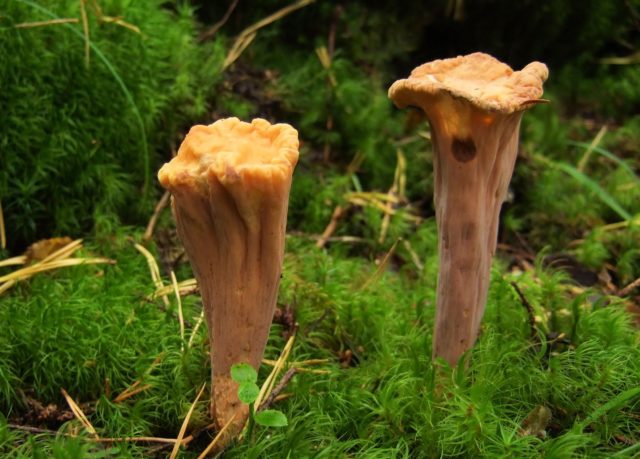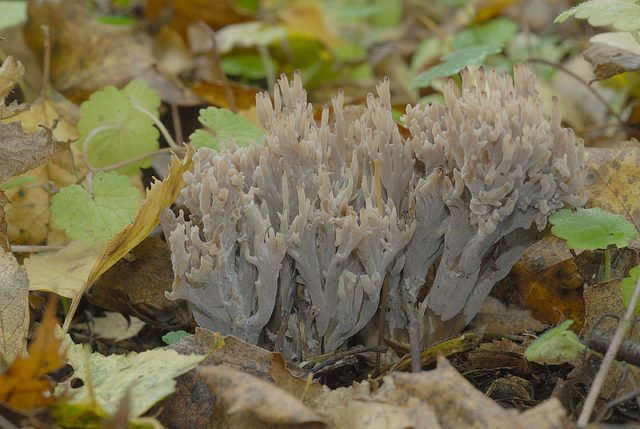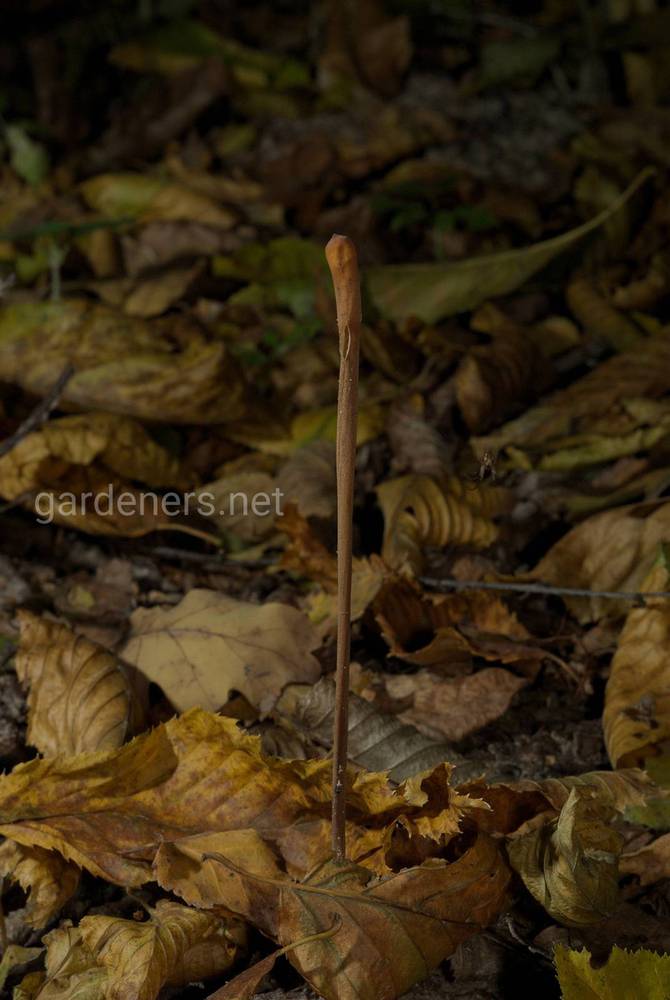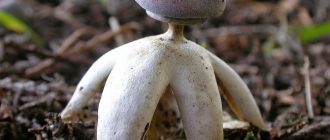Places of growth of horned horns.
Horned hornets bear fruit from September to October. Places of growth are deciduous and mixed with oak and birch forests. You can find them on grassy lawns, next to paths. Horned horns settle on the leaf litter and twigs that have fallen to the soil. The species is rare. They grow in colonies and groups.

Evaluation of the edibility of the hornbeam.
Hornbeam can be eaten, but their edibility rating is low - they belong to the 4th category. Before cooking, the mushroom is boiled for 10-15 minutes, while the broth is drained. They have a good smell, and the flesh is practically tasteless, moreover, rubbery in consistency.
Related species.
Amethyst horned - a conditionally edible relative of the horned horned. Its fruit body is branched, resembling a coral or bush. The color of the fruiting body is bright - brown-lilac or lilac. The fruiting body may be sessile or it may have a very short stem. The branches of the fungus become covered with fine wrinkles as they age. The pulp is white, and when dry it turns purple. The pulp does not have a pronounced taste and smell.

Amethyst horns grow in coniferous-deciduous and deciduous forests. They settle alone, and sometimes in small groups in the form of a scythe. Fruiting from August to October.
The horned reed is also conditionally edible. The shape of its fruit body is lingual, often slightly flattened. The surface of the fungus is dry and smooth; in old age, the surface may be slightly wrinkled at the base. The color is pale cream, and after the ripening of the spores it becomes yellowish. The pulp is dry, odorless, whitish in color.

Reed horns grow from July to September. The places of their growth are mixed and coniferous forests. You can find these mushrooms in mosses, perhaps they form mycorrhiza with them. They bear fruit in small groups. The species is not common.
False doubles
The pistil slingshot has no dangerous counterparts. Therefore, mushroom pickers may not be afraid that they will find a poisonous variety. A close relative is the truncated horned horn, but its cap is flat, not round. Otherwise, they are similar - in size, color and structure of the flesh. Widely distributed in coniferous forests.

There is a fusiform horn. It belongs to the inedible, but not dangerous species. The body is elongated, even, cylindrical. The colors are yellow and fawn; on the cut and when pressed, the color does not change or darken.

There is also an ungulate horn. Mushrooms resemble a head of cauliflower - many shoots of a reddish hue grow from one base. The bases are white, the branches have small sharp edges on top.

Unlike pistil horned, it is endowed with good taste, it also belongs to endangered species. Therefore, it is undesirable to collect it.

There is also a gray slingshot, similar to corals. The twigs are single or accrete, off-white in color. The pulp does not differ in taste or smell, it is very fragile. The mushroom is edible, but due to the lack of special qualities, it is not eaten.
Cooking use
Before cooking, you need to properly prepare them. Rinse the mushrooms thoroughly under cold running water. Since they have a sinuous structure, the dirt penetrates into the most difficult places. Then we boil them for 30 minutes. The water in which they were boiled is poured out. It is absolutely impossible to use it. Rinse again under running water and set to cook for 10 minutes. Then we rinse with cold water. Now you can start preparing various dishes.
A simple recipe for a delicious mushroom soup.To begin with, we cut all the vegetables, namely potatoes, onions and carrots (you can add half a Bulgarian pepper). Fill everything with cold water and cook until half cooked. Then add the mushrooms and 15 gr. butter. In winter, add a few cloves of garlic to the soup. As soon as the soup boils, add salt and pepper to taste. Reduce the heat to a minimum and cook for another 15 minutes. The peculiarity of this soup is that it can be eaten not only hot, but also cold. When serving - sprinkle with dill and add a spoonful of sour cream.
For the second, you can simply fry them in addition to the main dish, for example, mashed potatoes or buckwheat porridge. To begin with, fry the onion in vegetable oil, pre-chopping it finely. Add chopped mushrooms. It is better to cut them larger. And fry until golden brown, just remember that you need to stir them constantly. Add salt and pepper to taste.
To make the dishes delicious, we will reveal a few little secrets to you. Firstly, they should be eaten no later than 4 days after harvest. Second, do not pickle or canned them. Otherwise, they will become bitter and rubbery. Thirdly, do not season the mushrooms with a lot of seasonings, otherwise you will kill their unique taste.
The best materials of the month
- Why you can't go on a diet on your own
- How to keep vegetables and fruits fresh: simple tricks
- How to beat your sugar cravings: 7 unexpected foods
- Scientists say youth can be prolonged
Time and place of fruiting
Despite the fact that the pistil horned is an infrequent guest in our forests, it is still possible to meet it, especially if you go in search of a pine forest, a beech grove, as well as mixed and broad-leaved natural plantations.
The main condition for a successful search is the presence of calcareous soils, which are the favorite growing environment for the species. In addition, rolled oats grow in heavy leaf fall and decaying wood in European, North American and East Asian green areas.
As for the intensification of fruiting, its peak falls on the period from mid-August to early September. This feature is explained by the fact that the variety loves not only warmth, but also humidity, and night temperature drops inherent in this pore only contribute to the development of mycelium.
If autumn turns out to be especially warm without early frosts, then horns can appear throughout September and even in the first decade of October. Another distinguishing feature of this unusual fungus is its tendency to grow in groups, forming entire colonies. And if the mushroom picker is lucky enough to stumble upon a horned mushroom, then it is highly likely that it will be a whole family.
Species of horned mushrooms
According to different classifications, the horned mushroom family (Latin Clavariaceae) includes about 120 different species. Here is a photo and description of some of the brightest representatives of horned mushrooms:
- Alloclavaria purpurea (Clavaria purpurea). The fungus is a single elongated cylindrical fruiting body, up to 10-15 cm high, with pointed or rounded tips. Their color is light purple, with age it becomes light brown, sometimes ocher, clay or beige. Usually they grow in dense groups, each of which can contain up to 20 pieces. Clavaria purpurea grows, mainly in coniferous forests. According to some sources, it forms mycorrhiza with the roots of conifers and mosses. The main habitat is North America, but it is found in the temperate zone of Russia and Europe, as well as in China and Scandinavia. There is no data on the edibility of the mushroom, however, as well as on its toxicity.
- Clavulina coral (Horned crested horn). Forms a bushy fruiting body with many small processes. The height of the bush can reach 10 cm. The tops of the fruit bodies are flat, comb-like, pointed.The color of the mushroom is white, milky, sometimes slightly yellowish or creamy, the flesh is brittle, white. It grows from July to October in mixed or coniferous forests, on soil or litter from fallen forest debris. It can grow both pointwise and in large groups. The mushroom is not poisonous, but it is usually not eaten because of its bitter taste. However, this does not prevent some lovers of culinary experiments from trying it, as evidenced by the available reviews.
- Ramaria yellow (Horny yellow, Deer horns). This is a rather large mushroom, it can reach a height of 20 cm, while its diameter can reach 16 cm.The fruit body is a massive central part of white color, resembling a cabbage stump, from which numerous shoots grow in different directions, slightly similar to branching antlers (hence the name - deer horns). Their color is yellow, lighter closer to the base, becomes bright at the periphery. When pressed, the color of the mushroom changes to cognac. Grows in mixed and coniferous forests, the peak of growth is observed in late summer and early autumn. Widely distributed in the forests of Karelia, found in the Caucasus, Western and Central Europe. It belongs to edible mushrooms, however, yellow horned horns are harvested only at a young age, since adult specimens begin to taste very bitter. Before starting to cook yellow ramaria, the fruiting bodies of the mushroom must be soaked and heat treated.
- Ramaria is beautiful (Rogatic is beautiful). In shape, it resembles a dense bush with a height and diameter of up to 20 cm. It consists of a massive, bright pink leg, which turns white with age, as well as numerous yellow branches with yellow-pink tips. When pressed, it turns red. With age, the fruit bodies lose their brightness and turn brown. It is found in deciduous forests, grows on soil or old rotted foliage. It is not used for food, because if ingested, it can cause severe intestinal disorders.
- Clavulina amethyst (Horny amethyst). It has elongated branching fruiting bodies fused at the base of a very unusual purple color. The pulp is white with a lilac tint. The mushroom bush can reach a height of 5-7 cm. It grows mostly in deciduous forests, the peak of growth occurs in September. Often found in large colonies. Amethyst horned, despite its unusual "chemical" color, is quite edible, but it is not recommended to fry it because of its peculiar taste. It is best used for drying, boiling, or making mushroom sauce.
A short video about how horned horns grow in the wild:
Taxonomy, characteristics and a short description of the structure
Pistil horned - this is the name of this mushroom of an unusual club-shaped shape.
Systematics:
| Family | – | Clavariadelph |
| Genus | – | Claviadelfus |
| View | – | Pistil horned |
In Latin, the mushroom has a name - Clavariadelphus pistillaris.
And also this representative of the forest kingdom may have the following names - Clavate Horn, Hercules Horn, Pistil Claviadelfus.

One of the features is the absence of a clear classical division into a cap and a leg.
The fruit body of the fungus is rather large in size and has an elongated, widened rounded cap. It grows in height up to 20, sometimes up to 30 cm.Its diameter is about 5 cm.
The color of Claviadelphus pistil varies depending on age: a pastel light yellow shade is typical for young mushrooms, bright yellow and even orange shades for mature ones.
Since this type of fungus does not have a pronounced cap (the leg smoothly passes into the cap), the hymenophore (the lower part of the mushroom cap) covers almost the entire surface of the fruiting body and has a smooth structure in young units, and in older units it becomes wavy due to the appearance of grooves ... The spores are oval and white or pale yellow.
Hercules pulp also changes its characteristics depending on age. In young animals, it has a dense white structure, in adult mushrooms it becomes softer and acquires a spongy structure. After cutting, the pulp slowly changes color to purple-brownish, while the smell is not sharp and even pleasant, and the taste is bitter.
The stalk of the pistil cylindrical horn is narrowed downwards. It is slightly lighter in color than the cap and has tomentose pubescence.
Claviadelfus pistil belongs to the representatives of the mushroom kingdom, which are included in the Red Book of Russia and are protected in 39 constituent entities of the country (mainly in the southern regions).
Precautionary measures
There are many plants that look like deer legs. Many of them are quite poisonous. Therefore, if you are new to this business, then ask an experienced mushroom picker to tell and show how to correctly collect and distinguish deer legs from other plants.
Remember that after harvesting, before cooking, you must rinse and process them well, because if not cooked correctly, they can have a serious negative effect on your body.
Do not harvest near the pistes, as the plants quickly absorb toxic substances.
More fresh and relevant health information on our Telegram channel. Subscribe: https://t.me/foodandhealthru
We will be grateful if you use the buttons:
Edibility of horned mushrooms
As noted above, there are no poisonous species among horned animals. Nevertheless, mushroom pickers are wary of this family, its representatives have too unusual appearance.
Among them, a fairly large number of edible ones, according to the all-Russian classification of mushrooms in terms of nutritional value, they belong to the IV, last group, which includes, for example, mushrooms and oyster mushrooms.
The table shows the main types of slingshots by edibility:
| Edible | Inedible |
| AmethystYellowBunny TongueGoldenTruncated | FusiformCrestStraightPestal FawnFistulaPurple |
The inedibility of horned fish is determined by their bitter taste or pungent aftertaste. Some species have a strong, unpleasant odor. All edible species can be eaten after cooking.
Important! Cut slingshots should be consumed within 3-4 days, otherwise they will become bitter. For the same reason, they are not preserved.
Slingshots have no particular nutritional value, but they can be used for medical purposes. This is due to the natural substances of the tryptamine group that are part of the fruiting body. There is evidence that with the help of an extract from the horns, they successfully treat diseases such as Crocker's sarcoma and Ehrlich's carcinoma.
The harm from the use of slingshots inside can only be associated with indigestion or with unpleasant taste sensations. There is no information about serious poisoning with these mushrooms, which led to serious consequences for the body.
Important! The use of mushrooms for children under 10 years of age is contraindicated.
When collecting horns for eating, you need to remember that only young specimens should be taken, the older the mushroom, the more bitter it is. In addition, it is worth adhering to the general rules for all lovers of "quiet hunting":
- Fungi are capable of accumulating heavy metals and radionuclides. Therefore, you cannot take specimens growing along the railway, busy highways, growing on the territory of abandoned military facilities or industrial zones.
- If there is no 100% certainty in the edibility of the mushroom, then you should not take it.
Description of the horned hornbill.
The fruiting body of the horned hornbeam has an elongated clavate shape. The width of the lower part of the fruiting body reaches 0.3 centimeters, and the upper one is larger - 0.5-1 centimeters. The height of the horned horns ranges from 8 to 10 centimeters, and sometimes reaches 15 centimeters.

The fruiting body of the hornbeam is thin, initially it is almost acicular with a sharp apex, over time it becomes clavate. And the top is rounded. It is cylindrical at the bottom, obtuse at the top. Later, the shape comes to lobe-like. Rarely, the fruiting body is beveled. Its surface is wrinkled, matte. The color changes from yellowish ocher to yellowish brown. The base of the fruiting body is bristly pubescent. The inside of the mushroom is hollow.
The flesh of the horned fistus is dense, elastic. The color of the pulp is cream. It may have a pleasant smell or odor may not be felt at all.

Application
Mushrooms are used for medicinal purposes
Deer horns have a lot of useful properties due to their chemical composition.
Application in medicine
From their micellar structure, they learned to isolate polysaccharides, which have the property of stopping Ehrlich's carcinoma. It is scientifically proven that the extract from blackberries successfully fights sarcoma.
These organisms are natural antibiotics and contain a serotonin precursor and hydroxy tryptophan. For medicinal alcoholic tinctures, they are harvested young, until the bodies have acquired a dark brown hue.
Cooking applications
A yellow mushroom is added to soups, and a reed mushroom is better suited for pates or caviar. Forest corals are used to prepare delicious snacks and pie fillings. Tongue or yellow are great for frying in batter.
For preparations for the winter, drying or freezing, they are pre-soaked well and washed several times so that all the bitterness comes out and only a pleasant aroma remains.
Harm and contraindications
Only familiar mushrooms should be collected, it is necessary to carefully sort out the harvested crop in order to exclude the ingress of poisonous individuals. Otherwise, severe poisoning occurs.
These unique and beautiful horns absorb all the toxins from the environment, so there is no need to collect them near roads or factories. Even edible species in this case can have a negative effect on the gastrointestinal tract.
It is better for pregnant women to consult a gynecologist before consuming a forest delicacy. For children under 14 years old, it is possible to introduce it into the diet only after consulting a pediatrician.
Let's go to rest together
If you are going to go to rest in these places for mushrooms or fishing or just sunbathe, then invite like-minded people to your company, it is more interesting to relax together.
All posted ads can be viewed in the Travel Book
Alekseevsky forest
A small group of friends | Going to a famous place looking for a company | There are places in the car | We are going to the woods for Alekseevka, today. To see what there is now from the mushrooms, we will stop by the Silver Spring. Join whoever wishes.
Other offers:
Country club "Berezina Rechka"
Fishing club "Forelyandiya"
Recreation center "Polyanka"
Recreation center "Rose of the Winds"
Fishing base "Dolina"
Country club "Atmosphere"
Country club "Luck"
Recreation center "Laguna"
Recreation center "Golden Trout"
Hunting farm "Bolshaya Tavolozhka"
Recreation center "Domostroitel"
Fishing club "Forest Fairy Tale"
Recreation center "Hare ears"
Recreation center Chardym-Dubrava
Fishing base "Volzhsky Bereg"
Recreation center "Izbushka"
Recreation center "Razdolye"
Recreation center "Manor" Mountain air "
Recreation center "Ivolga"
Fishing "On Kalinikhe"
Vershinins' trout farm
Recreation center "Sunflower"
Fishing bases and clubs of the Saratov region
Recreation center "Prirechnoye"
Recreation center "Metalist"
Tourist Saratov, 2018-2020. All rights reserved.
Edible mushrooms
Reed horn (lat.Clavariadelphus ligula) is an edible mushroom from the genus Clavariadelphus. This mushroom is also called truncated horned, claviadelfus reed, mace and hind tongue. The fungus is noticeable, the fruiting body is club-shaped, not branching, colored in orange-yellow or cream tones. Butterflies prefer to grow only in coniferous forests, and they settle exclusively under pine trees in mosses, possibly forming mycorrhiza with them.You can find them on the edges, near stumps and tree trunks. Reed horns grow in the litter, in moss, on the remains of wood buried in the soil and in densely fallen needles. Butterflies bear fruit in groups, sometimes huge, meeting in hundreds or more specimens. Fruiting is observed from July to November, while active growth occurs in October. It comes across infrequently, but in large groups.
The mushroom is considered edible, 4th category, with low palatability. Massively these mushrooms are not harvested anywhere, it is not clear what to do with it. Polysaccharides were isolated from the mycelium culture of horned beetles, which stop the growth of Ehrlich's carcinoma and sarcoma-180 by 90%. The mushroom contains melatonin, a serotonin precursor and hydroxytryptophan. These mushrooms are natural antibiotics.
The fruiting body of the reed stalk has neither a leg nor a cap, is vertical, lingual, somewhat widened in the upper part (sometimes up to the shape of a pistil), often slightly flattened; height 7-12 cm, thickness 1-3 cm (in the widest part). The surface of the fruiting body is smooth at first, later becomes uneven, wrinkled. The inside of the mushroom is hollow.
Its base is fleecy-felt. The color of young fruit bodies is cream or yellow, and then becomes ocher-yellow or orange-yellow, old fruit bodies are brown with a purple tint. This shade is most noticeable at the base of the mushroom. The head of the mace is rounded or flattened, its diameter is 0.5-3 centimeters. The head narrows noticeably towards the base. The pulp is light, whitish, dry, without a noticeable odor.
The pulp of the reed stalk at an early age is soft, spongy, tender, elastic, then it becomes dry and brittle. A noticeable purple tint appears at the fracture of the pulp. The pulp does not have a tangible taste and smell, but sometimes it can be bitter. Spore powder is white, light yellow or cream. The spores of this fungus are long, cylindrical in shape.
The reed horn can be confused with other representatives of the genus Clavariadelphus, especially with the more rare (apparently) pistil horned, Clavariadelphus pistillaris. The one is larger and more "pistil" in appearance. From representatives of the genus Cordyceps, a beige-yellow color of fruit chalk can be a good distinguishing feature.














































